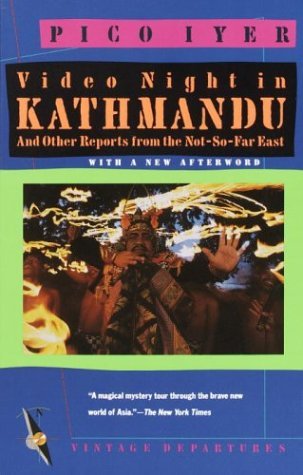This baseball driven journey through Japan finds something more foreign than angels in the outfield.
Traveling to Japan as the last of many stops throughout Asia, Time writer Pico Iyer visits everything from “American Spirit” stores to Zen temples, finding a land both entrancing and ominous. Tension seems to be a hallmark of Iyer’s narrative: between tradition and westernization, perfection and crudity, and between Japan and the U.S. Baseball becomes the lens through which Iyer ultimately views Japan, and his conclusions are more indicative of his own American unease than of Japan itself.

Video Night in Kathmandu And Other Reports From the Not-So-Far East by Pico Iyer 400pp Vintage $14.95
Beginning his travels in Tokyo, he quickly notes that the Japanese seem obsessed with American culture, but never seem to quite get it right or make it their own. Slipping early on into an Orientalist desire, he contrasts the ludicrous signs for “Jerry Beans” and “Gland Beef” with the elegance of kimono clad women and complains that in Japan’s tradition culture seems to have been cast off in favor of crude western imitation. To understand this, he decides to examine the Japanese appropriation of the most American of pastimes: baseball.
Baseball is the most important and long developing example of the underlying point of Iyer’s narrative: that Japan is surpassing the U.S. Fear permeates his writing, leading him to view every Japanese courtesy with suspicion, and conclude that Japan may imitate the West and desire Western approval, but ultimately detests the West. Iyer sees Japan as taking Western ideas and perverting them, yet at the same time perfecting them. In baseball, Iyer sees a game robbed of its soul, where players are ground down to automatons and then built back up into winning machines. The mass cheers of the Hanshin Tigers’ supporters are not the exhortations of fans but rather the thunderous mass of Japan out to overtake America. Iyer implies that Japan threatens the very fabric of American tradition and what is more, the Japanese way is better, perfect. Iyer becomes obsessed with perfection as a part of the Japanese national character, extending all the way from Tokyo Disneyland to traditional Zen temples.
Iyer visits both Tokyo Disneyland and Kyoto Zen temples, finding in each different perfections. He marvels that Tokyo Disneyland creates the same perfect world as its U.S. counterpart, but that the people who fill it seem to blend into the perfection rather than (as Americans do) contrast with it. By contrast, he finds perfection in the quiet and peace of Zen gardens and temple paths, walking alone, and for no one but himself. In the midst of writing laced with American anxieties the section devoted to these contrasting perfections is a welcome respite. It is a further testament to Iyer’s skill as a writer that he balances Disneyland and temples together, managing to avoid all but the slightest Orientalism. He appreciates the Zen gardens not as a part of a grand Romantic desire for the Orient, but for the peace they bring his mind, especially in light of the busy Disney. At the same time he does not hesitate to enjoy Tokyo Disneyland or remark that Disneyland is one of Japan’s most popular attractions for the Japanese themselves. Unfortunately, this otherwise balanced account ends once again with Iyer’s fear of Japan, as he notes that this perfectionism when applied incorrectly leads to horror.
Iyer concludes his narrative with an account of American gaijin (foreigners) playing in Japanese baseball. Mostly American major-leaguers past their prime, these men usually find great success in Japan, but quickly find themselves alienated. In Japan they made top statistics and top dollar, but did so in the grueling Japanese way. Iyer’s account of gaijin players not only reiterates his sentiment that Japan is dangerous, but figuratively shows his fears for America. Americans may not cease to be successful or rich, but they could be forced to achieve in the Japanese system. The Japanese way, as Iyer seems to draw it, is duplicitous and group minded: always eager to show a best and beloved face to the world, while carving up and perfecting that world as it likes. Iyer’s writing is persuasive, and he is clearly both fascinated by, and terrified of, Japan. For him it is both familiar and foreign a threatening combination best exemplified by his final comment: that in 1984 Olympics Japan took the Gold medal in baseball against America on American soil.
It is worth remembering that Pico Iyer visited Japan in 1987-88 and that his account was first published in 1989. Japan was a source of tremendous concern for the U.S. at that time and that clearly shows through in Iyer’s writing. Japan’s bubble economy had not yet burst, “Japan Inc.,” was at its peak, and the Japanese were buying up property throughout the U.S. and flooding America with their goods. The duplicity Iyer finds in Japanese courtesy and throughout Japan is disturbingly reminiscent of the old World War II era saying “You can never trust a Jap.” Paranoia over growing Japanese power, and the seeming impossibility of stopping it, colors Iyer’s entire work. As a result, the narrative is of tremendous use not as an account of Japan, but as a window into American anxiety over and perception of Japan at the end of the 1980s.
Entry contributed by Charles Fliss